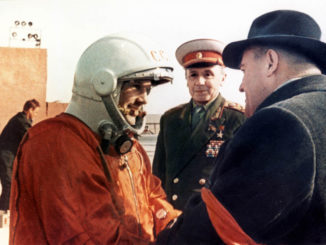
Two years after it paraded through the streets of Los Angeles following a cross-country ferry flight from Florida, the space shuttle Endeavour was loaded with a Spacehab logistics module Thursday ahead of the orbiter’s planned transition to a vertical display on a mock launch pad in 2018.
The Spacehab pressurized module, known as Flight Unit No. 3, flew on eight space shuttle missions from 1996 to 2000, helping deliver supplies to the Russian space station Mir and the International Space Station.
The installation of the Spacehab module and other items into the shuttle’s cargo pay has been dubbed “Go for Payload” by the California Science Center, which hosts Endeavour and plans to expand the shuttle display in the coming years.
Using special equipment to prevent damage to sensitive components, workers opened up Endeavour’s clamshell-like payload bay doors. The lightweight composite doors opened under their own power in orbit, but they require support to overcome gravity on Earth.
Suspended from a crane, the Spacehab module was lowered into Endeavour’s 60-foot-long, 15-foot-wide payload bay Thursday.
Check out photos of the delicate operation.
The module launched aboard shuttles Endeavour, Atlantis and Discovery on the STS-79, STS-81, STS-84, STS-86, STS-89, STS-96, STS-101, and STS-106 missions.
The Spacehab module to be displayed inside Endeavour will be in the “single module” configuration, but it flew its missions as part of a larger double module to haul up more cargo.
California Science Center constructed a mock bulkhead to close off one side of the Spacehab module where it once connected to form a double unit.
The museum, located in Exposition Park just southwest of downtown Los Angeles, modeled its “Go for Payload” campaign to recreate Endeavour’s cargo bay as it appeared during the STS-118 mission in August 2007.
The STS-118 crew included mission specialist Barbara Morgan, a former teacher, and flew up experiments and supplies to the International Space Station.
Other items to be positioned inside Endeavour’s cargo bay include a replica docking system and external airlock, a mock-up of a tunnel adapter between Endeavour’s crew cabin and the Spacehab module, and a dummy robot arm.
“We’ve acquired all of the payload items (real and replica),” said Dennis Jenkins, the science center’s Endeavour project director, in a statement. “In an extremely unusual move, and showing exactly how important our future display is to the air and space museum world, the Smithsonian allowed us to remove several parts from Discovery at the National Air and Space Museum to support our payload installation. We are very grateful to the Smithsonian for allowing us to acquire them and their continuing support.”
The science center will also add more than 7,000 feet of wiring, allowing the museum to light the shuttle’s payload bay, flight deck and middeck.
The cargo bay doors will be closed again by the end of October.
The work on Endeavour this month is a prerequisite to the science center’s plans to mount the orbiter on an external fuel tank and a set of inert solid rocket boosters.
“This installation will provide guests the opportunity to see the inside of the payload bay when it’s on display in the launch position in the Samuel Oschin Air and Space Center, which is currently in the design phase,” said Jeffrey Rudolph, president of California Science Center. “Being able to see inside the shuttle is essential for Endeavour’s enduring mission of advancing science learning.”
“We have been chasing parts all over the country for the past two years,” Jenkins said. “To attach Endeavour to the external tank requires massive structural pieces that NASA manufactured in New Orleans. Unfortunately, these pieces were destroyed on every mission since the external tank was not recovered and burned up during re-entry.
“Luckily, one un-flown external tank (ET-94) remains at the Michoud Assembly Facility and NASA was supportive in donating the hardware to us,” Jenkins said. “In addition, we needed to find specialized bolts, nuts, and washers, some weighing up to 20 pounds.”
Rudolph said the science center is making “steady progress” in a $250 million fundraising campaign to help pay for the Samuel Oschin Air and Space Center built to house Endeavour, which currently sits horizontally in a temporary pavilion.
Once the permanent display is open — currently scheduled for 2018 — Endeavour will be the only one of NASA’s flown orbiters shown as it appeared on the launch pad.
Space shuttle Atlantis, on display at the Kennedy Space Center Visitor Complex in Florida, is mounted with its payload bay doors open as if it was flying in space. Discovery rests on its landing gear at the Smithsonian Air and Space Museum’s Steven F. Udvar-Hazy Center in Virginia.
NASA’s Enterprise shuttle used for atmospheric approach and landing tests is at the Intrepid Sea, Air and Space Museum in New York City.
View our Endeavour archive chronicling the shuttle’s final mission and delivery to California for public display.



